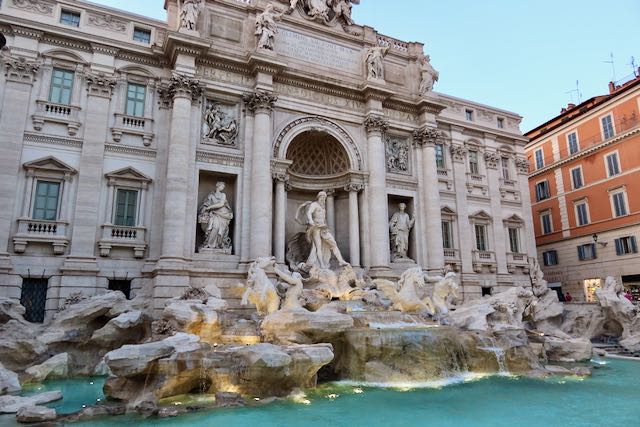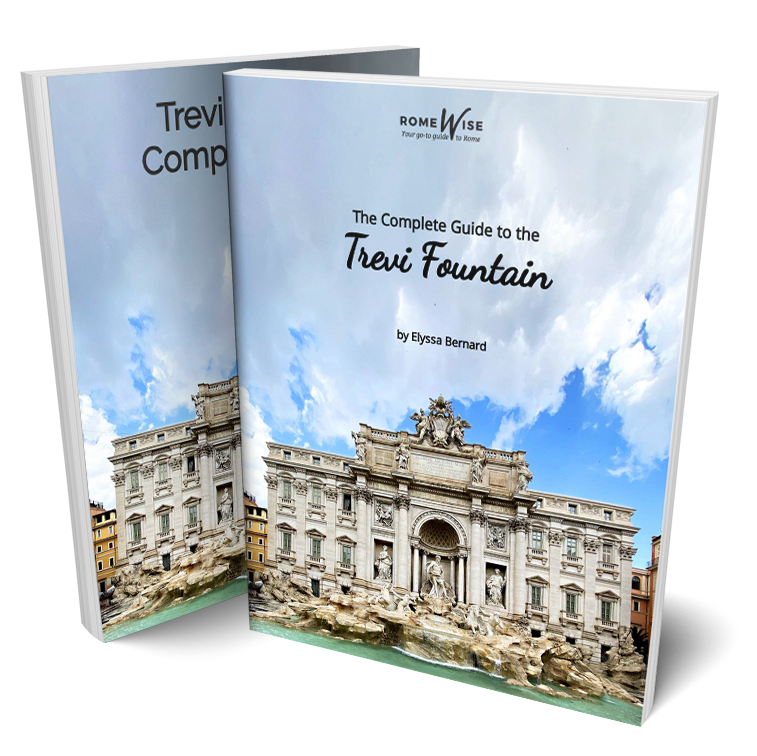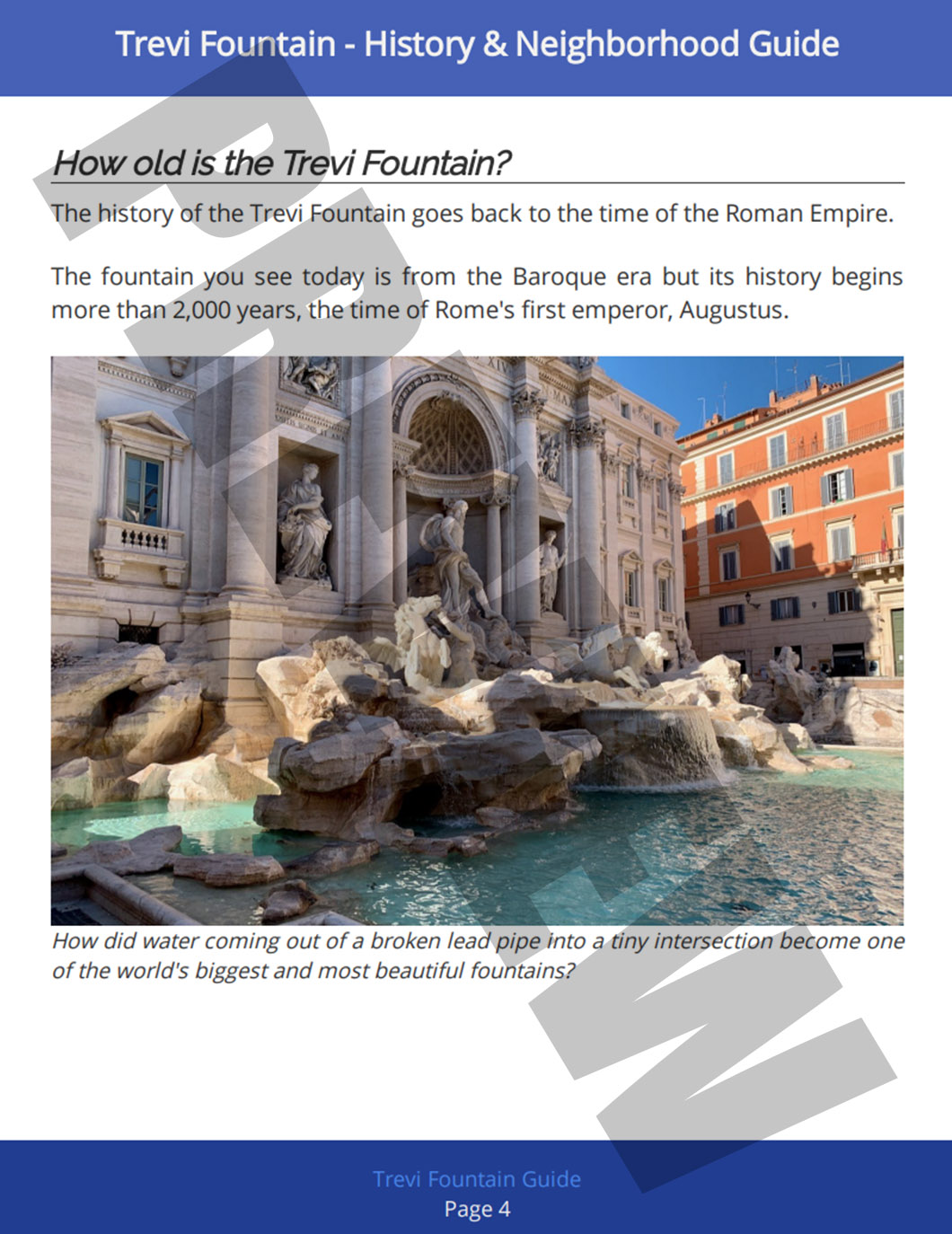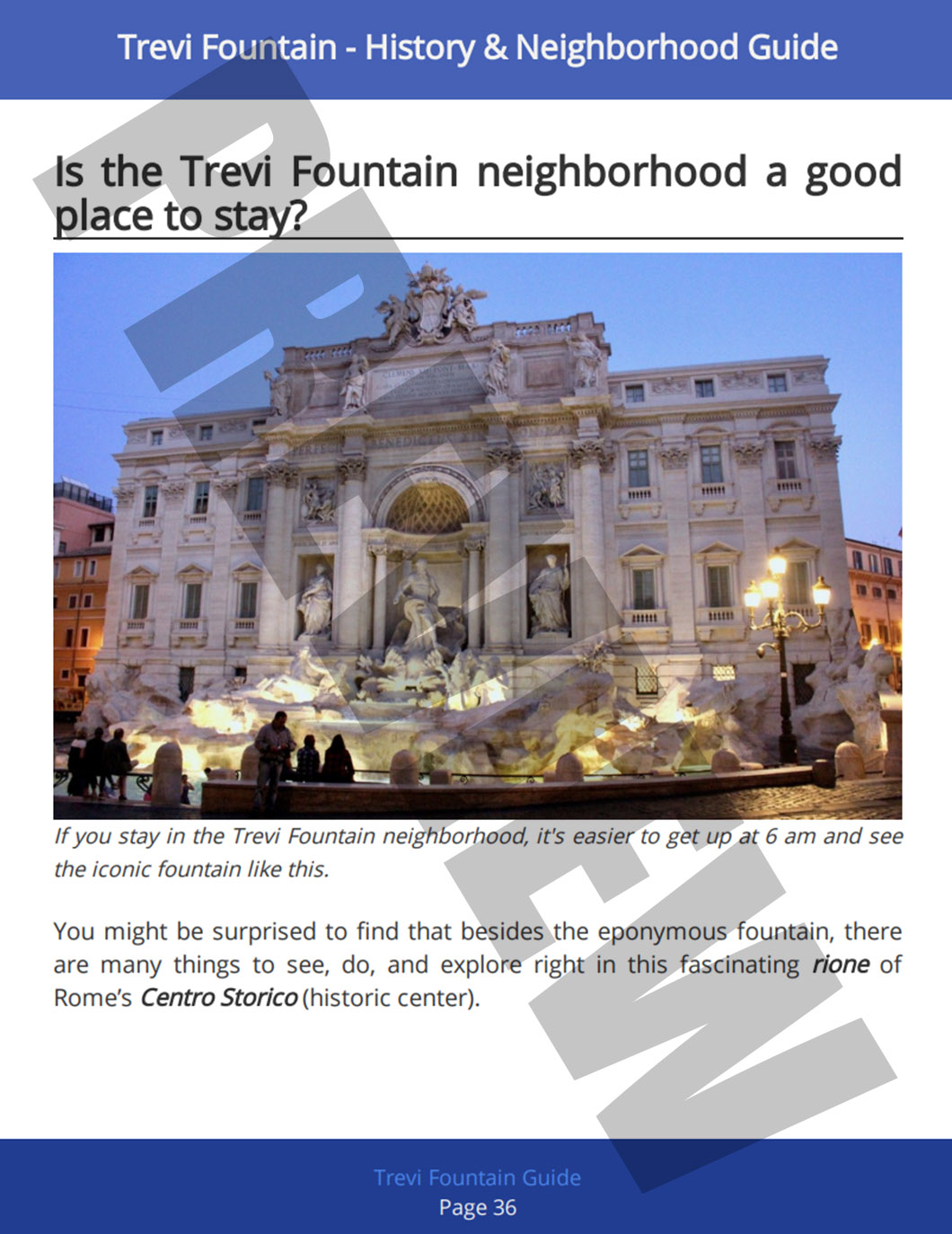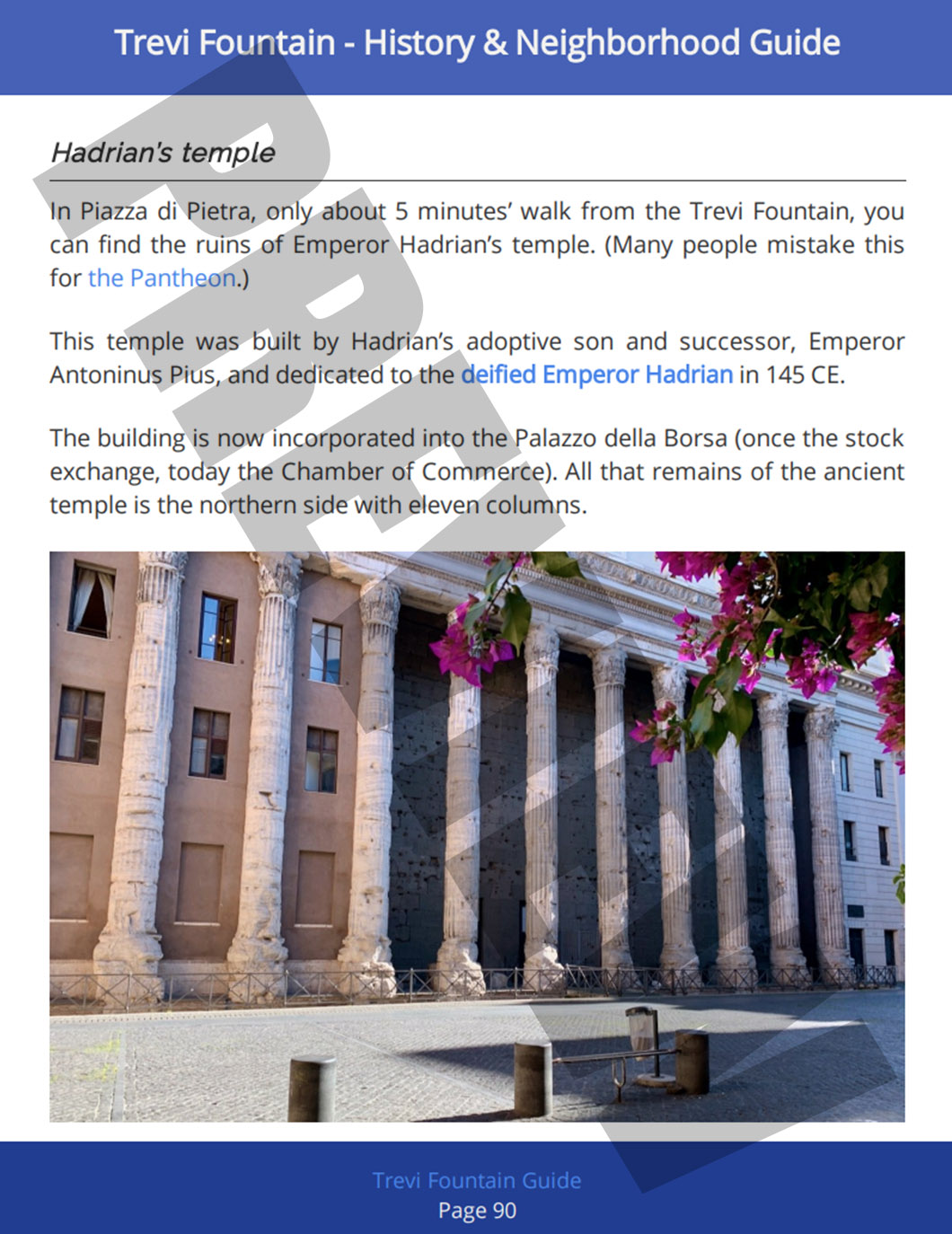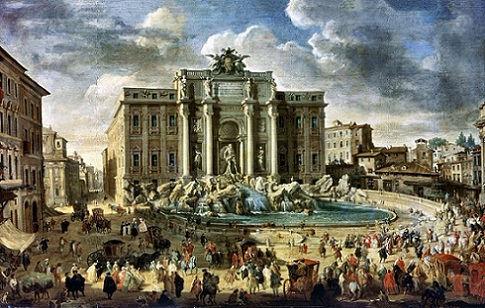- Sign up & get a FREE ebook Subscribe NOW!
- Romewise Home Page
- Trevi Fountain
- Trevi Fountain History
Trevi Fountain History - a fascinating tale of one of the world's most famous fountains
The Trevi Fountain history starts before the time of the Roman Empire.
How did water coming out of a broken lead pipe into a tiny intersection become one of the world's biggest and most beautiful fountains?
Trevi Fountain in Rome, Italy - history, art and artists, facts, legends, and more!
Here’s what you need to know the Trevi Fountain history, art, and architecture:
- How old is the Trevi Fountain?
- Where does the water for the Trevi Fountain come from?
- You can visit the source!
- Who designed the Trevi Fountain? Was it Bernini?
- Why is the Trevi Fountain so huge for the space it's in?
- What does the Trevi Fountain represent?
- What do the figures in the background stand for?
How old is the Trevi Fountain?
The Trevi Fountain (Fontana di Trevi in Italian) you see today in Rome took over 100 years to build.
This is because it had stops and starts due to budget constraints and changes in popes and architects over the years.
But even if the fountain you see today was completed in the 18th century, its history goes back more than 2,000 years.
TREVI FOUNTAIN History - ORIGINS IN ANCIENT ROME
General Marcus Vipsanius Agrippa (first Roman Emperor Augustus' right-hand man) constructed an aqueduct in 19 BCE to help bring water to the thermal baths near the Pantheon.
That aqueduct ended in a plain little fountain where the church of Saint Ignatius stands today.
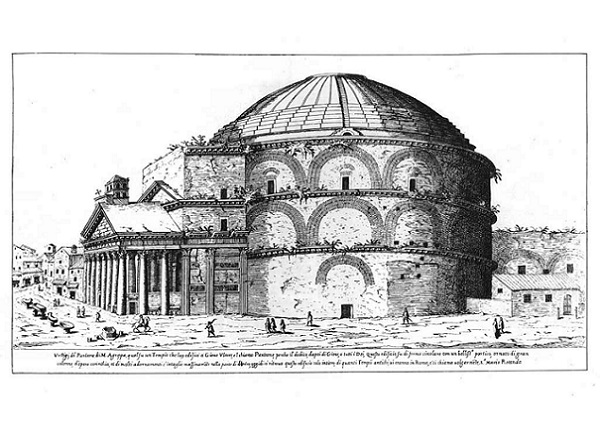 The water that feeds the Trevi Fountain today was originally brought to Rome by Agrippa to feed the baths behind the Pantheon, as seen imagined in this 16th century etching by Di Etienne Duperac. Wikimedia - public domain.
The water that feeds the Trevi Fountain today was originally brought to Rome by Agrippa to feed the baths behind the Pantheon, as seen imagined in this 16th century etching by Di Etienne Duperac. Wikimedia - public domain.Complete Guide to the Trevi Fountain eBook
The Trevi Fountain is one of Rome's most iconic landmarks, but do you know why it's so well-known?
With this eBook, find out what makes the Trevi Fountain special, plus extensive information about the Trevi neighborhood (Rione) - where to shop, see unusual things, enjoy beautiful views, and much more!
Topics covered include:
- The history of the Trevi Fountain and surrounding area, which goes right back to ancient Rome!
- Romewise's recommendations on what do around the Trevi Fountain
- Lesser-known facts and tips to make the most of your visit to the Trevi Fountain
What else is included in this e-book?
- 150+ pages of information covering everything related to the Trevi Fountain
- Dozens of stunning and original photos showcasing the Trevi Fountain
- + much more!
Trevi Fountain History - The Aqua Virgo aqueduct in Rome
The aqueduct was called Aqua Virgo, meaning "Virgin Water".
Its name today is Acqua Vergine.
A legend says it was named for a young maiden (virgin) who showed some Roman soldiers where the spring was.
You can see this scene depicted in bas-relief on the right hand side of the fountain above Oceanus' head.
More likely the word "virgo" referred to the purity of the water.
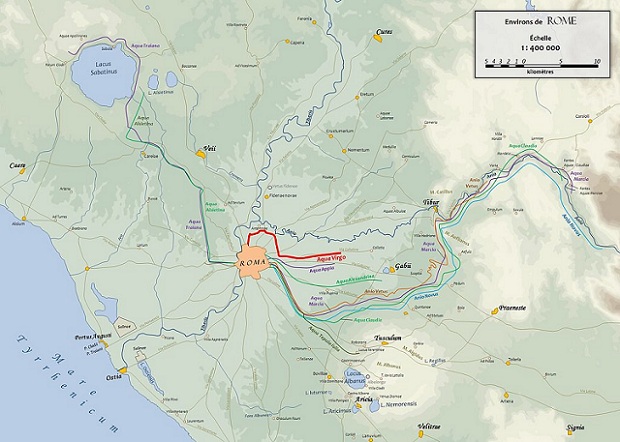 The Aqua Virgo aqueduct in Ancient Rome is the beginning of the story of the Trevi Fountain History. Cassius Ahenobarbus - Wikimedia Commons
The Aqua Virgo aqueduct in Ancient Rome is the beginning of the story of the Trevi Fountain History. Cassius Ahenobarbus - Wikimedia CommonsThe Acqua Vergine is the only Roman aqueduct that never stopped working, and the only aqueduct from Ancient Rome still supplying water to Rome today.
This aqueduct was one of 11 Roman aqueducts and was one of the main sources of water for the Romans until the Ostrogoths sacked the city in 537 and destroyed (almost) all the aqueducts and fountains.
While the Goths did a lot of damage, there was still a little water coming in from the Acqua Vergine.
So even during those dark times until the aqueducts were fully restored in the late 16th century, there was this one small source of clean water for Romans to use in their daily lives.
Besides this water source, the Romans also got water from the Tiber river. Ick.
In any case, part of the destruction resulted in the water pipe no longer reaching its original destination at the baths behind the Pantheon.
Instead, the water came out of a lead pipe right at this intersection of three streets where the Trevi Fountain is today, below the Quirinal Palace.
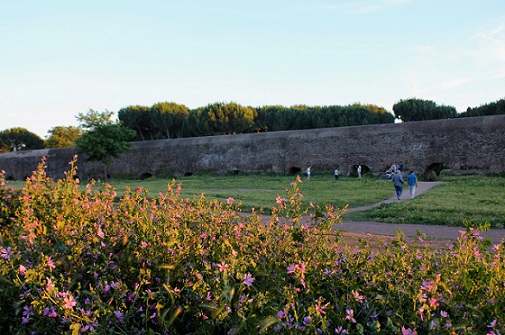 There are remnants of Roman aqueducts all around Rome. One of the best places to see them is in the Parco degli Acquedotti, which is part of the Appian park.
There are remnants of Roman aqueducts all around Rome. One of the best places to see them is in the Parco degli Acquedotti, which is part of the Appian park.Interested in finding out more about the underground secrets of Rome? Take this tour for a fascinating look at some of the Eternal City's best-known sites!
Visit a piece of Trevi Fountain History - Vicus Caprarius
Just a stone's throw away from the Trevi Fountain Rome, you can visit the original site of the source of the water that fills the Trevi Fountain, the "Acqua Vergine", or Virgin Water Aqueduct.
At the Vicus Caprarius (named for the Ancient Roman street that passed here), there are remains of ancient Roman houses there, along with other Roman artefacts.
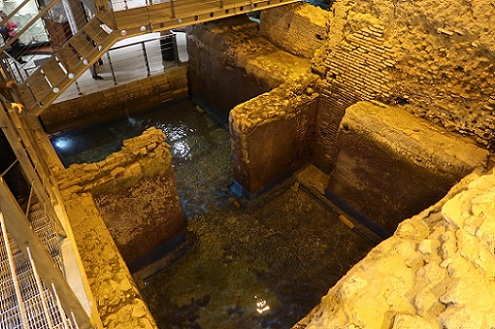 To get right up close and personal with Trefi Fountain history, visit the nearby Vicus Caprarius to see the source of the water.
To get right up close and personal with Trefi Fountain history, visit the nearby Vicus Caprarius to see the source of the water.It's easy to visit this site on your own but you can also take a tour.
Two more places to see a piece of Trevi Fountain history
Besides the above-mentioned Vicus Caprarius, you can spot the original Acqua Virgo aqueduct at two other nearby locations in Rome:
In the basement of Rome's flagship Rinascente store you can see a big stretch of the Acqua Vergine aqueduct.
There is also a small film and light show that sometimes loops and displays right on the ruins, telling the story of the aqueduct.
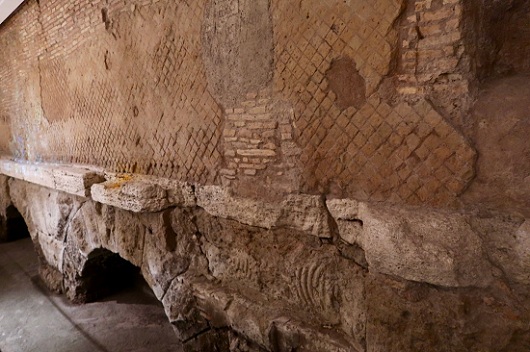 In the basement of the Rinascente department store, you can see a long stretch of the Acqua Vergine aqueduct, from the time of Augustus.
In the basement of the Rinascente department store, you can see a long stretch of the Acqua Vergine aqueduct, from the time of Augustus.On nearby via del Nazareno, there is a grating behind which you can spot another piece of the Acqua Virgo aqueduct.
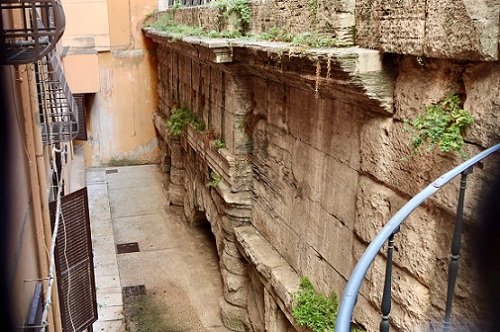 I took this photo of the Acqua Vergo aqueduct through a metal grating. But it's still pretty cool to see such an intact piece of it right in the street!
I took this photo of the Acqua Vergo aqueduct through a metal grating. But it's still pretty cool to see such an intact piece of it right in the street!Trevi Fountain History - The Renaissance
In the early Renaissance, popes began restoring some of the broken aqueducts, ordering decorative fountains as their outlet.
This is why almost all the big fountains in Rome have a papal shield on them, to let you know who was responsible.
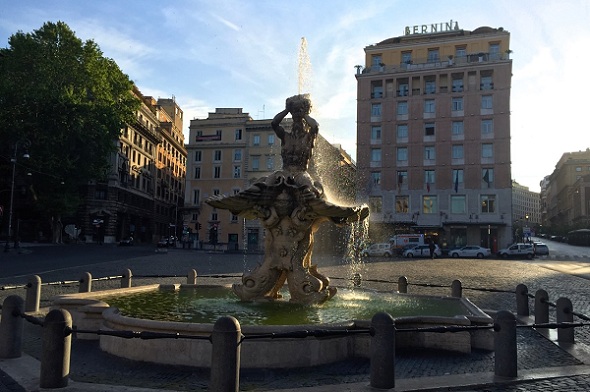 On the base of the Baroque Fontana del Tritone by Gian Lorenzo Bernini in Piazza Barberini, you can see the papal crest and symbols of the pope responsible for commissioning this beautiful fountain, Pope Urban VIII Barberini.
On the base of the Baroque Fontana del Tritone by Gian Lorenzo Bernini in Piazza Barberini, you can see the papal crest and symbols of the pope responsible for commissioning this beautiful fountain, Pope Urban VIII Barberini.The aqueducts were still not fully restored and the water pressure was not great, but it was a start.
(Most of the fountains you see in Rome today are from the Baroque era, around the 1600s-1700s, including the Trevi Fountain.)
The first fountain on the site of the current Trevi Fountain was designed by Leon Battista Alberti in 1453 under Pope Nicholas V.
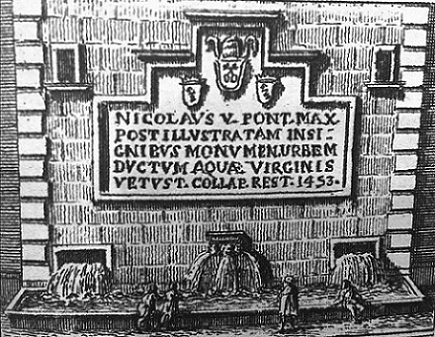 Trevi Fountain History - This is what the Trevi Fountain looked like before the one you see today existed. It was built in 1453 under Pope Nicholas V and designed by Leon Battista Alberti. From the website www.vicuscaprarius.com.
Trevi Fountain History - This is what the Trevi Fountain looked like before the one you see today existed. It was built in 1453 under Pope Nicholas V and designed by Leon Battista Alberti. From the website www.vicuscaprarius.com.The fountain had three outlets and poured into a rectangular basin.
It was marked with a wall plaque naming the pope and the aqueduct.
For nearly 100 years, this was the only supply of clean water in Rome.
Who designed the Trevi Fountain? - Not Bernini, not really
The first pope to start thinking about what would become the fountain we see today was Pope Urban VIII (Barberini), who was a big fan of Gian Lorenzo Bernini.
In the 16th century, popes had begun living in the Quirinal Palace up on the Quirinal Hill.
The pope's bedroom looked down on this little intersection.
When Pope Urban VIII moved into the palace, he did not think his view was interesting enough.
In 1629, he asked Bernini to draw some sketches for a new fountain so he could have something nicer to see out his window.
But the pope also had other priorities like waging war against the duchy of Parma.
He spent most of the Papal State's money on this war and so the fountain project languished due to lack of funds.
⛲️ Discover Rome's most enchanting piazzas and fountains ⛲️
With an expert local guide, wander cobbled streets to stunning landmarks like Piazza Navona, the Spanish Steps, and the iconic Trevi Fountain. Step inside the magnificent Pantheon, a testament to ancient engineering, and soak in the unique ambiance of the Eternal City. Book now for the perfect introduction to Rome’s artistic wonders!
Trevi Fountain History - Bernini's contribution
Bernini did get to do a little bit of work on this project before he was forced to abandon it.
He began by clearing out some old houses which resulted in the creation of a small square.
He then turned the existing fountain 90 degrees south so that the new fountain could be more easily seen from the Quirinal Palace.
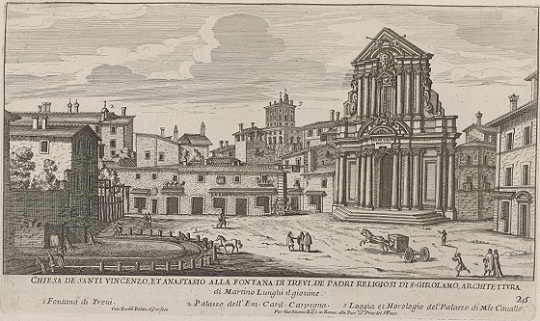 In the Trevi Fountain history, there is a bit of Bernini even if he didn't design the final fountain. This is a sketch of the previous Trevi Fountain in the 17th century. Giovanni Battista Falda (1667-1669). Wikimedia Commons - Public domain
In the Trevi Fountain history, there is a bit of Bernini even if he didn't design the final fountain. This is a sketch of the previous Trevi Fountain in the 17th century. Giovanni Battista Falda (1667-1669). Wikimedia Commons - Public domainBernini got so far as to build two huge semicircular basins, one inside the other.
He also placed a base in the center, presumably to support a decorative sculpture.
Bernini had nothing to do with the central sculpture group we see today, but you can see his influence in the final design: a mix of nature and whimsy, a lot like his Fontana dei Quattro Fiumi in Piazza Navona.
Trevi Fountain History - how it was Finally built
Another guy actually won, but he was a Florentine and that would not do.
So a runner-up who was Roman was chosen to keep it all in the family so to speak.
Although frankly, I am pretty glad that Salvi got the job.
For the next hundred years or so, several popes half-heartedly thought about getting this fountain project going.
It was not until 1732 that the Trevi Fountain entered the final stretch of its creation.
Pope Clement XII held a contest to select a new architect for the fountain and Nicola Salvi won.
Nicola (Niccolò) Salvi is the architect most credited with the current design of the Trevi Fountain.
Unfortunately, he died when it was only half-way finished, so he did not see its completion.
The last architect to put the final touches on the fountain was Giuseppe Pannini.
The Trevi Fountain was finally completed and inuagurated in 1762, even though it was already a working fountain long before then.
The perfect 3-day itinerary in Rome
Trying to figure out how to organize your visit to Rome? I've got the perfect 3-day itinerary for first-time visitors (or those who have not been here in a while.) It works for a 2.5 day visit as well.
In my 3-day itinerary, you'll see all the major must-see Rome attractions like the Vatican, Colosseum, Trevi Fountain, Pantheon, Piazza Navona, Spanish Steps, and much more.
And if you have more time, or want suggestions for extra/other things to do, you'll find that there too.
Visit my page with the best 3-day itinerary in Rome for first-timers.
Why is the Trevi Fountain so enormous for the space it's in?
Measuring 26 meters (86 ft) high and 49 meters (161 ft) wide, the Trevi Fountain is the largest Baroque fountain in Rome.
Going back to the beginning of the Trevi Fountain history, the original "fountain" was just a lead pipe bringing fresh water into Medieval Rome via the Acqua Vergine.
In the 17th and 18th centuries this giant fountain was designed so the pope could have something beautiful to look at from above.
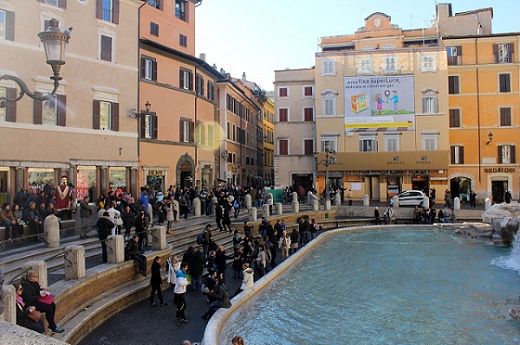 You can see here that the basin takes up most of the square. This is one reason why it's often very crowded around the Trevi Fountain Rome. There just is not a lot of room for people in the square itself!
You can see here that the basin takes up most of the square. This is one reason why it's often very crowded around the Trevi Fountain Rome. There just is not a lot of room for people in the square itself!But not longer after that, when popes were not living in the Quirinal Palace any more, it didn't matter if buildings grew back up around this little square.
And so they did.
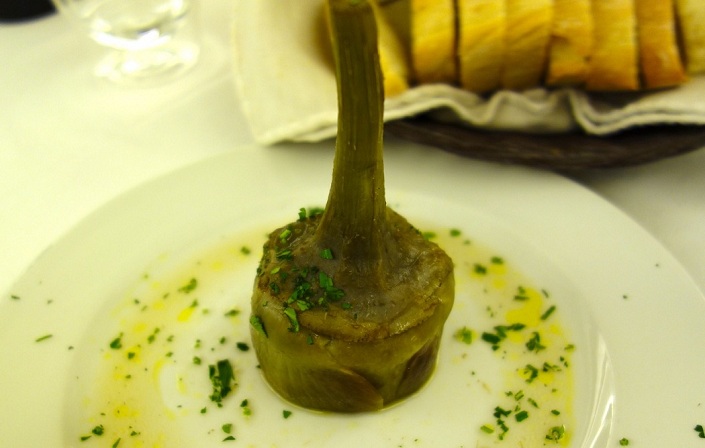 Where to eat near the Trevi Fountain
Where to eat near the Trevi Fountain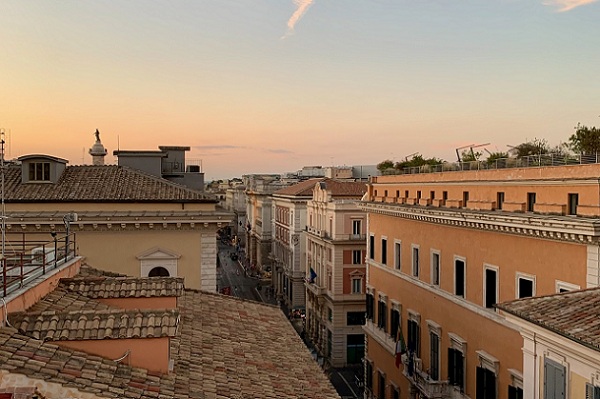 Where to stay near the Trevi Fountain
Where to stay near the Trevi Fountain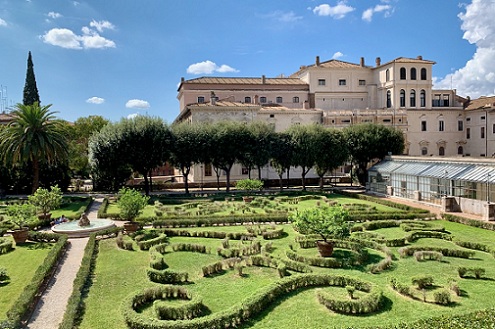 Trevi Fountain neighborhood guide
Trevi Fountain neighborhood guide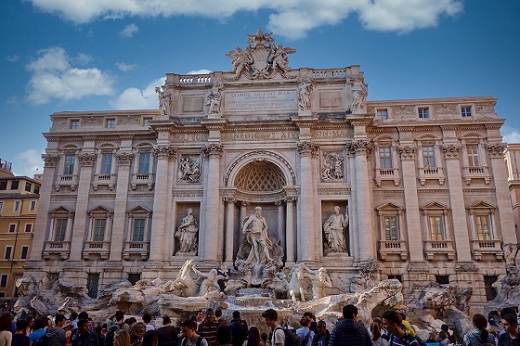 How to visit the Trevi Fountain
How to visit the Trevi FountainWhat does the Trevi Fountain represent?
Trevi Fountain history - Where did the name Trevi come from?
The name of Trevi probably comes from the Latin tres viae, or tre vie in Italian, which means "three ways."
The fountain stands at the crossroads of 3 streets.
There is another possibility to explain the name of the famous fountain - The aqueduct passed through a small town outside of Ancient Rome called Trebium.
The Roman goddess Diana, was sometimes called Trivia.
She was the protector of roadways, in particular, three-way crossroads.
Ready to plan your trip?
Book your train
Planning to travel between cities in Italy and other parts of Europe?
Use Trainline to see all the different options available across the different rail companies.
Find your hotel
Find your perfect place to stay in Rome.
Use Booking.com to choose between hotels, guesthouses, and self-catering apartments in neighborhoods throughout the Eternal City.
Buy your TurboPass
Purchase the convenient Turbopass and visit all of Rome's top attractions including the Colosseum, Pantheon, and Vatican.
With one handy pass, it's all included.
The architecture of the Trevi Fountain
The Trevi Fountain history is chock-a-block with the influence of different artists and architects who proposed ideas for its design over the centuries.
They came up with a lot of different looks, some of them involving obelisks or tall columns.
The winning project took its inspiration from the 16th century Fontana dell'Acqua Paola on the Gianicolo Hill (Trastevere).
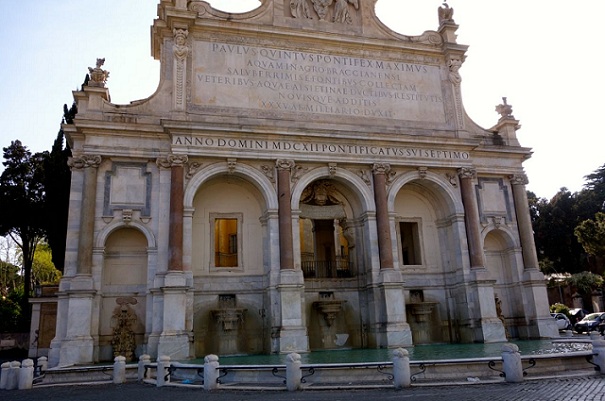 Trevi Fountain history and architecture - The 16th-century Fountain of Acqua Paola on the Gianicolo Hill, nicknamed by Romans as "er Fontanone", was the inspiration for the architectural shape of the Trevi Fountain.
Trevi Fountain history and architecture - The 16th-century Fountain of Acqua Paola on the Gianicolo Hill, nicknamed by Romans as "er Fontanone", was the inspiration for the architectural shape of the Trevi Fountain.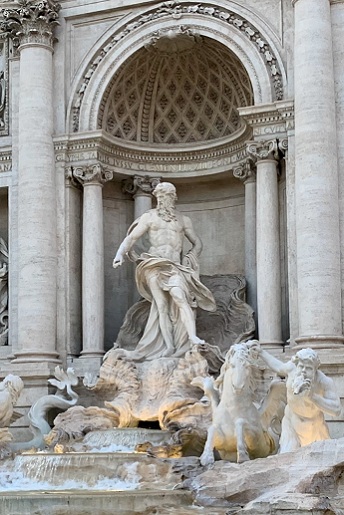 The setting of Oceanus is very interesting - the exedra and columns are homages to ancient Roman architecture.
The setting of Oceanus is very interesting - the exedra and columns are homages to ancient Roman architecture.The central figure of Oceanus was designed by sculptor Pietro Bracci (who also made beautiful angels you can see in the loggia of Santa Maria Maggiore.)
Note the exedra behind him.
This apse-like hollow is right out of ancient Rome.
Don't forget to bring these essential travel items with you!
Disclosure: If you make a purchase through a link on this page, I may receive a small commission - at no extra cost to you. Thank you for supporting my site!
And the ancient-Rome inspired columns (based in part on those of the Colosseum) that surround Oceanus are noteworthy because they are not attached to the walls of the exedra.
This allows for a more 3-dimensional look, and better light/shadow composition.
 Where to eat near the Trevi Fountain
Where to eat near the Trevi Fountain Where to stay near the Trevi Fountain
Where to stay near the Trevi Fountain Trevi Fountain neighborhood guide
Trevi Fountain neighborhood guide How to visit the Trevi Fountain
How to visit the Trevi FountainTrevi FOuntain History and art - What do the statues on the Trevi Fountain symbolize?
There are a lot of sculptures in the background of the Trevi Fountain.
Here's what they mean:
Oceanus - the god in the center of the Trevi Fountain
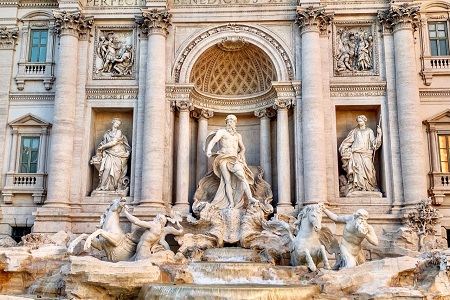 The main theme of the Trevi Fountain is the calming of the waters. Oceanus, not Neptune, represents all the earth's waters.
The main theme of the Trevi Fountain is the calming of the waters. Oceanus, not Neptune, represents all the earth's waters.The main figure in the centre of the Trevi Fountain is the god Oceanus, not Neptune as many think.
Neptune almost always carries a triton (like a three-pronged spear), and has a dolphin nearby.
Oceanus represents a huge river that flows all around the earth, and from which all other bodies of water are formed.
Hippocamps - sea gods
There are two horses (actually they are called "hippocamps", from Greek mythology, and are really half horse, half fish.)
Each of these sculptures is held by a Triton (Tritons are gods of the sea, and sons of Poseidon).
One horse seems quite riled and strong, and the other docile and calm. These represent the moods of the seas.
Health and Abundance
There are two statues on either side of Oceanus: On the left is Abundance, represented by the basket of fruit she is holding, and on the right, is Salubrity, or health, symbolised by the laurel wreath around her head (Apollo's plant), and the snake wrapped around her legs (from Greek mythology.)
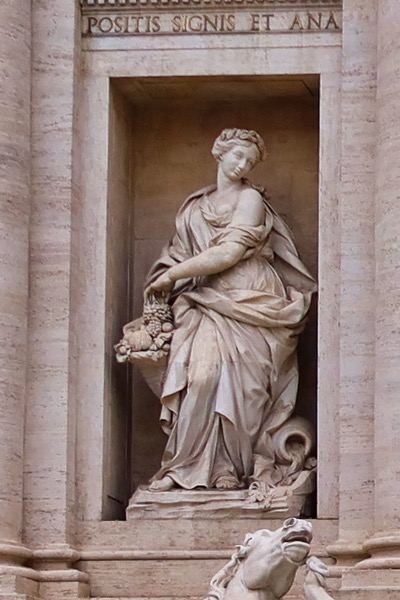 Abundance
Abundance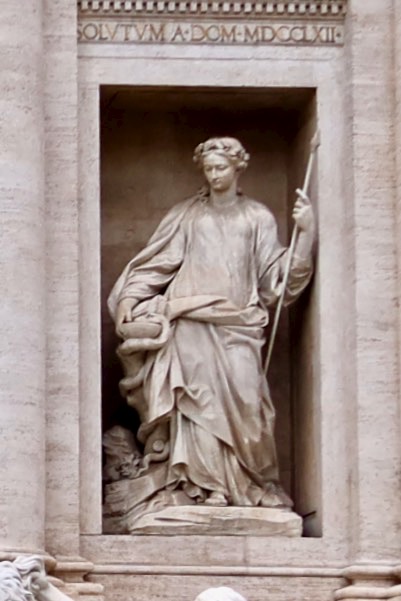 Salubrity
SalubrityAncient Rome scenes
Moving your eyes upward, you can see two reliefs on either side of the exedra where Oceanus stands.
The relief on the left shows Agrippa commanding his generals to build the aqueduct.
The relief on the right tells the story of the virgin maiden who showed the Roman soldiers where to look for water.
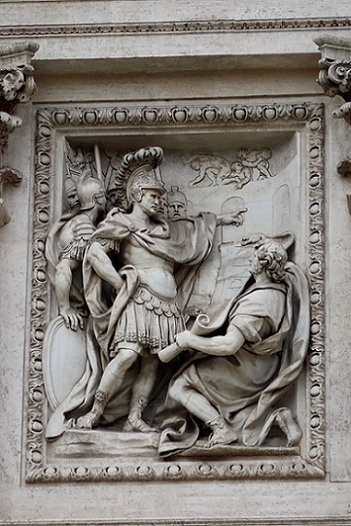 Agrippa directing his soldiers to build the Aqua Virgo Aqueduct.
Agrippa directing his soldiers to build the Aqua Virgo Aqueduct.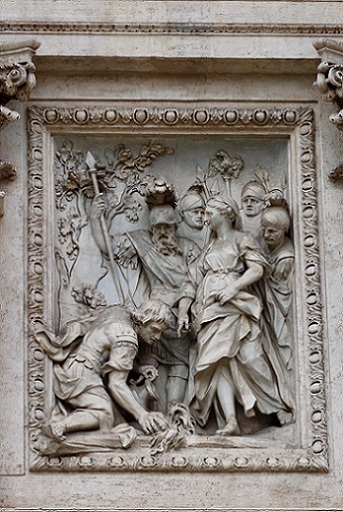 A young virgin maiden shows the Romans where to find the water source.
A young virgin maiden shows the Romans where to find the water source.Four sculptures showing earth's bounty
Further still up the fountain sculpture, you can see four goddesses that represent earth's bounty thanks to water.
If you go to either side of the fountain, you can really see in great detail the items they are holding.
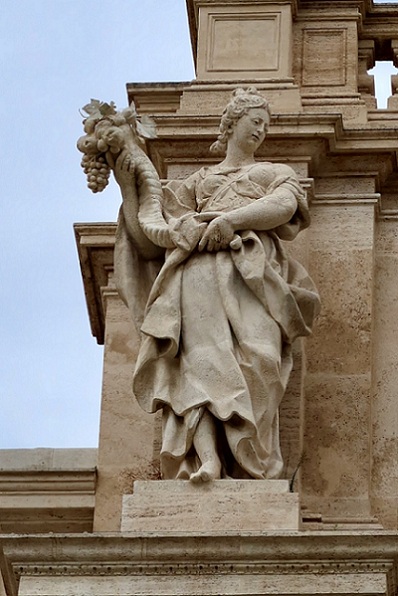 Abundance of fruit - holding a cornucopia
Abundance of fruit - holding a cornucopia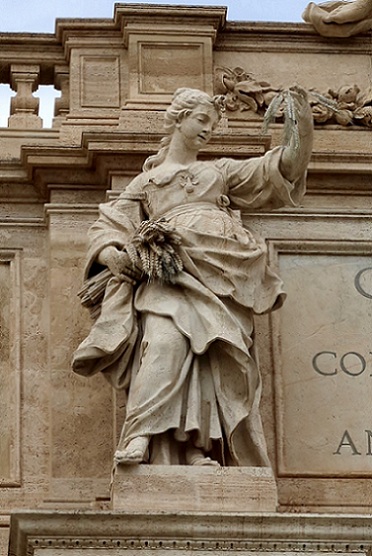 Fertility of crops - holding wheat
Fertility of crops - holding wheat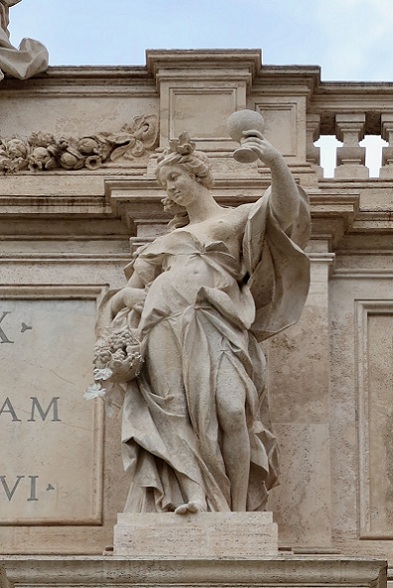 Autumn harvest - holding grapes
Autumn harvest - holding grapes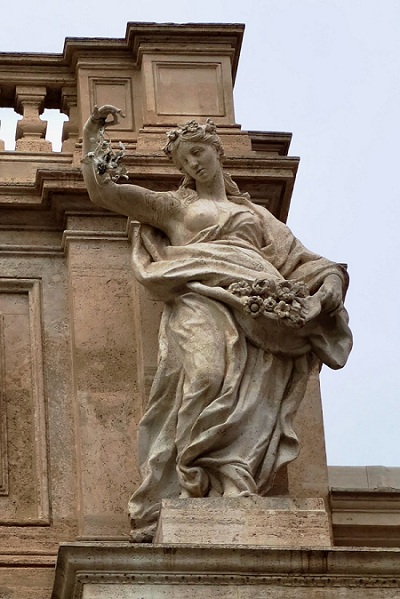 Joy of gardens - holding flowers
Joy of gardens - holding flowersMore about the Trevi Fountain
This page is about Trevi Fountain history, art, and architecture.
For more about the Trevi Fountain, you can visit these pages:
 Where to eat near the Trevi Fountain
Where to eat near the Trevi Fountain Where to stay near the Trevi Fountain
Where to stay near the Trevi Fountain Trevi Fountain neighborhood guide
Trevi Fountain neighborhood guide How to visit the Trevi Fountain
How to visit the Trevi FountainRomewise's Top Travel Resources
Ready to book your trip to Rome? Take a look at these helpful links to companies we use and trust:
- Keep your travel spending simple with the Wise card, which removes all the worry about exchange rates and high transaction fees all over the world
- Search for and book your perfect accommodation
- Our complete guide to what to pack for Rome
- The number one travel accessory, a multi-point travel adapter and voltage converter
- Browse a huge range of tours in Rome and beyond
- Experience unique tours and special access to Rome's most popular sights
- Protect yourself with comprehensive travel insurance
Within this post there are some affiliate links for products and services. For more details about our affiliate policy click here.
Get your 100% free Rome trip planner now!
Simply sign-up today for our free newsletter and get the Romewise Quick Start guide to Rome:
We are committed to respecting your data. Click for our Privacy Policy.
Comments? Questions? Suggestions?
Please come over to the private Romewise Facebook group and join in the conversation.
You will often find me there, happy to answer your questions / comments!
You will also meet other Rome lovers and experts, too.
What are you waiting for?
- Romewise Home Page
- Trevi Fountain
- Trevi Fountain History

